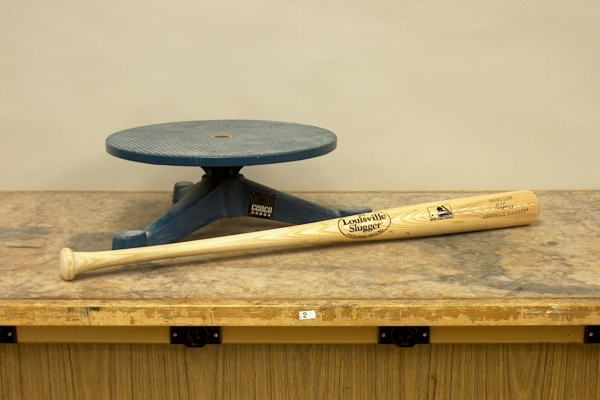
In this demonstration, you show the conservation of angular momentum by swinging the baseball bat while you are standing on the rotatable platform. (The platform sits on the floor; its placement on the table was for the purpose of photography only.) If you swing the bat around to your left, you give it an angular momentum vector that points upward. This results in you and the platform rotating to your right, canceling the angular momentum you gave the bat. Swinging the bat to the right causes you and the platform to rotate to your left. In either case, as soon as you come to the end of your swing, everything stops rotating; with no external forces acting on you, the bat or the platform, the total angular momentum of the system must remain zero.
As noted in hte explanation for demonstration 28.45 – Rotatable stool, dumbbells, just as linear momentum is conserved for processes involving objects undergoing linear motion, so is angular momentum conserved for objects that are rotating. Whereas the linear momentum of an object equals mv, where m is the mass of the object, and v is its velocity, the angular momentum of an object equals Iω, where I is the object’s moment of inertia, and ω is its angular velocity. That is, L = Iω. L points along the object’s axis of rotation. If you curl the fingers of your right hand in the direction of rotation, and then extend your right thumb, your thumb points in the direction of L. Thus, if you stand on the platform and swing the bat to your left, the angular momentum that you give the bat points upward. To conserve angular momentum, absent any external forces, you and the platform must acquire angular momentum that points downward, which means that you and the platform must turn to your right. If you swing the bat to your right, the angular momentum you give it points downward, so the angular momentum that you and the platform acquire must point upward, and you and the platform turn to your left.
When you first stand on the platform, if you and the platform are not rotating, your initial angular momentum is zero. This means that as you swing the bat, you and the platform rotate in the opposite direction, but as soon as the bat reaches the end of your swing, you and the platform stop rotating.
You can also demonstrate the so-called “spaceman’s move,” which is similar to the maneuvers that cats perform during a fall so as to land on their feet. First, extend your arms outwards, but in such a way that you don’t exert any torque about your central axis; extend them radially. Then twist them around in one direction. Your body turns in the opposite direction. Now lower your arms, bringing each one in radially. Now, repeat the process. By swinging your arms around, but before and after the swing moving them only in radial directions, you can repeatedly exert a torque in one direction and thus, continue to rotate yourself in one direction or the other. This is possible because you can bring your arms in and out without exerting a torque, and during the process, the center of mass of the system comprising you and the platform does not move. It is interesting that while this type of move is possible for rotational motion, it is not possible with respect to linear motion. If an astronaut floating freely inside a spacecraft tries to move himself along a straight line, all he can do is to move in one direction and then back to the same starting point. This is because there is no way for him to extend or retract his limbs so as to move in a straight line, without moving them along that line. Since the astronaut’s center of mass cannot move without the influence of an external force, all he can do by extending and retracting his limbs is to oscillate back and forth. As described above, he can, however, rotate himself around to face in different directions.